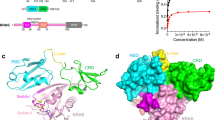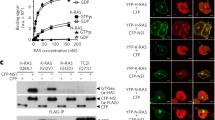Abstract
THE Ras proteins are key regulators of the growth of eukaryotic cells, but their direct target enzymes, or 'effectors', are unknown1. The protein encoded by the c-raf-1 proto-oncogene is thought to function downstream of p21ras because disruption of Raf blocks signalling by Ras in a number of systems2–5. Here we report that the amino-terminal cysteine-rich regulatory region of p74c-raf-1 expressed as a glutathione-S-transferase (GST) fusion protein binds directly to Ras with relatively high affinity (50 nM). The binding is strictly dependent on the Ras protein being in the active GTP-bound conformation rather than the inactive GDP-bound state. Raf–GST interacts with wild-type and oncogenic Ras (Val 12) but fails to interact with a biologically inert effector mutant of Ras (Ala 38) and a dominant negative mutant (Asn 17). A peptide based on the effector region of Ras inhibits the interaction. Raf–GST acts as a potent competitive inhibitor of the GTPase-activating proteins p120GAPand neurofibromin. In addition, Raf itself displays weak GTPase-stimulating activity towards Ras. It is therefore likely that Raf is a direct effector of Ras.
Similar content being viewed by others
References
Marshall, C. J. Trends Genet. 7, 91–94 (1991).
Kolch, W., Heidecker, G., Lloyd, P. & Rapp, U. R. Nature 349, 426–428 (1991).
Bruder, J. T., Heidecker, G. & Rapp, U. R. Genes Dev. 6, 545–556 (1992).
Han, M., Golden, A., Han, Y. & Sternberg, P. W. Nature 363, 133–140 (1993).
Dickson, B., Sprenger, F., Morrison, D. & Hafen, E. Nature 360, 600–603 (1992).
Rapp, U. R. et al. Cold Spring Harb. Symp. quant. Biol. 53, 173–184 (1988).
Ono, Y. et al. Proc. natn. Acad. Sci. U.S.A. 86, 3099–3103 (1989).
Farnsworth, C. L. & Feig, L. A. Molec. cell. Biol. 11, 4822–4829 (1991).
Martin, G. A. et al. Cell 63, 843–849 (1990).
Schaber, M. D. et al. Proteins Struct. Funct. Genet. 6, 306–315 (1989).
Farnsworth, C. L., Marshall, M. S., Gibbs, J. B., Stacey, D. W. & Feig, L. A. Cell 64, 625–633 (1991).
Mulcahy, L. S., Smith, M. R. & Stacey, D. W. Nature 313, 241–243 (1985).
Ahmed, S. et al. Biochem. J. 280, 233–241 (1991).
Downward, J. Bioessays 14, 177–184 (1992).
Bourne, H. R. & Stryer, L. Nature 358, 541–543 (1992).
Ahn, N. G., Seger, R. & Krebs, E. G. Curr. Opin. Cell Biol. 4, 992–999 (1992).
Hall, A. Science 249, 635–640 (1990).
Downward, J., Graves, J. D., Warne, P. H., Rayter, S. & Cantrell, D. A. Nature 346, 719–723 (1990).
Author information
Authors and Affiliations
Rights and permissions
About this article
Cite this article
Warne, P., Vician, P. & Downward, J. Direct interaction of Ras and the amino-terminal region of Raf-1 in vitro. Nature 364, 352–355 (1993). https://doi.org/10.1038/364352a0
Received:
Accepted:
Issue Date:
DOI: https://doi.org/10.1038/364352a0
- Springer Nature Limited
This article is cited by
-
The role of CRAF in cancer progression: from molecular mechanisms to precision therapies
Nature Reviews Cancer (2024)
-
Akt-mediated Ephexin1–Ras interaction promotes oncogenic Ras signaling and colorectal and lung cancer cell proliferation
Cell Death & Disease (2021)
-
Neurobiological Opportunities in Diabetic Polyneuropathy
Neurotherapeutics (2021)
-
Small molecule inhibitors of RAS proteins with oncogenic mutations
Cancer and Metastasis Reviews (2020)
-
New perspectives for targeting RAF kinase in human cancer
Nature Reviews Cancer (2017)





